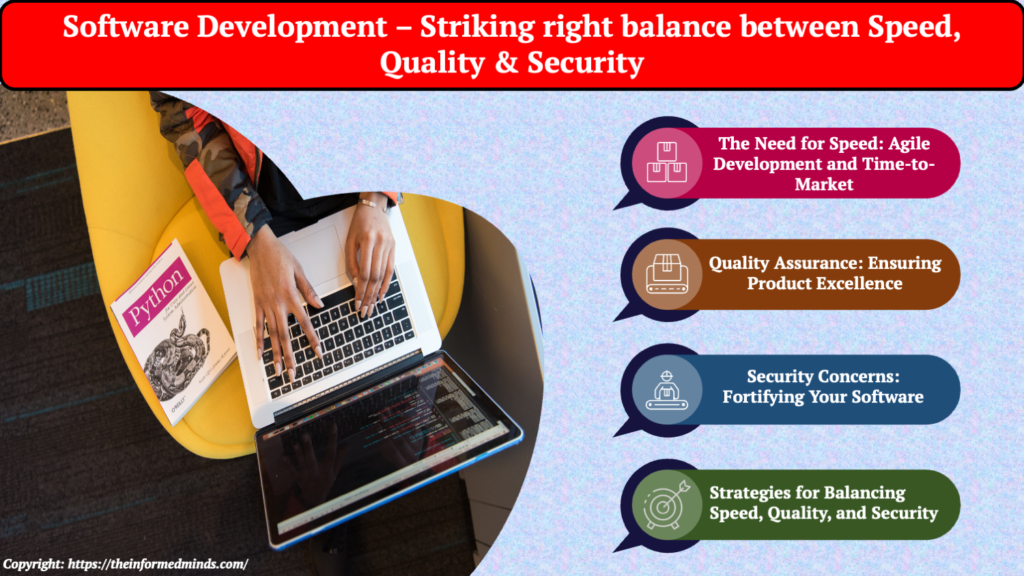To Share is to Show You Care!
In today’s fast-paced digital landscape, software development teams face a pressing challenge: delivering products swiftly while maintaining impeccable quality and security. As the demand for rapid deployment increases, so does the risk of overlooking critical quality assurance (QA) and security protocols. So, how can organizations navigate this tightrope? Let’s delve into strategies and best practices to harmonize speed, quality, and security in software projects.

The Need for Speed: Agile Development and Time-to-Market
Agile Methodologies
Agile methodologies such as Scrum and Kanban emphasize flexibility, collaboration, and responsiveness. By breaking down complex projects into manageable tasks or user stories, teams can prioritize work, adapt to changes swiftly, and deliver incremental value.
Iterative Development
Agile promotes iterative development cycles where small, functional increments are delivered regularly. This approach allows teams to gather feedback continuously, make necessary adjustments, and ensure alignment with stakeholder expectations.
Continuous Integration/Continuous Deployment (CI/CD)
CI/CD pipelines automate the integration, testing, and deployment processes, enabling teams to detect defects early, streamline workflows, and accelerate time-to-market.
Automation
Automation of routine tasks such as testing, code integration, and deployment reduces manual effort, minimizes errors, and facilitates rapid, reliable releases.
Quality Assurance: Ensuring Product Excellence
Robust Testing Protocols
Implementing comprehensive testing strategies such as unit testing, integration testing, and end-to-end testing is crucial to identify defects, validate functionality, and ensure product reliability.
Validation
Through rigorous testing, teams can validate software functionality, performance, and user experience, ensuring alignment with business requirements and customer expectations.
Code Reviews
Code reviews foster collaboration, knowledge sharing, and code quality improvement. By conducting peer reviews, teams can identify coding errors, security vulnerabilities, and performance bottlenecks early in the development lifecycle.
Best Practices
Encouraging adherence to coding standards, design patterns, and architectural guidelines enhances code quality, maintainability, and scalability.
Security Concerns: Fortifying Your Software
Secure Coding Practices
Adopting secure coding practices such as input validation, authentication, and data encryption is paramount to mitigate security risks, safeguard sensitive information, and protect against cyber threats.
Risk Mitigation
By integrating security controls into the development process, teams can identify and address vulnerabilities proactively, reducing the likelihood of security breaches and data compromises.
Penetration Testing
Conducting regular penetration tests simulates cyber-attacks, identifies vulnerabilities, and assesses the resilience of your software applications against evolving threats.
Resilience
Penetration testing helps organizations enhance the resilience of their software applications by identifying and addressing security weaknesses, ensuring robust protection against malicious activities.
Strategies for Balancing Speed, Quality, and Security
Prioritize Requirements
Collaborate with stakeholders to prioritize features based on business value, technical complexity, and security implications. By aligning priorities and expectations, teams can focus on delivering high-impact features while mitigating associated risks.
Implement DevSecOps
DevSecOps integrates security practices into the DevOps lifecycle, fostering a culture of shared responsibility, collaboration, and continuous improvement among developers, operations, and security teams.
Collaboration
By breaking down silos and promoting cross-functional collaboration, organizations can streamline workflows, enhance communication, and accelerate the delivery of secure, high-quality software.
Automate Security Testing
Leveraging automated security testing tools and techniques enables organizations to identify vulnerabilities, assess risks, and implement timely remediation measures, ensuring robust protection against cyber threats.
Educate and Empower Teams
Investing in continuous learning and development programs equips teams with the skills, knowledge, and tools required to navigate the complexities of modern software development effectively. By fostering a culture of excellence and innovation, organizations can drive continuous improvement, achieve strategic objectives, and sustain competitive advantage.
Conclusion
Balancing speed, quality, and security in software development is a multifaceted endeavor that requires strategic planning, collaboration, and continuous improvement. By adopting agile methodologies, robust testing protocols, and security best practices, organizations can optimize their development processes, mitigate risks, and deliver value to customers efficiently. Remember, in the world of software development, speed is essential, but not at the expense of quality and security. Strive for equilibrium, embrace innovation, and success will follow.
Frequently Asked Questions
Q1: What is the best way to ensure that developers frequently release high quality and secure software?
A: The best approach is to integrate quality assurance and security practices directly into the development process. Implementing robust testing protocols, conducting regular security audits, fostering a culture of collaboration and accountability, and leveraging automated tools and frameworks can help developers identify and address defects, vulnerabilities, and security risks proactively.
Q2: How do you find a balance between the speed and quality of your technical deliverables?
A: Finding a balance between speed and quality requires prioritizing requirements, adopting agile methodologies, implementing continuous integration/continuous deployment (CI/CD) pipelines, fostering collaboration among cross-functional teams, and investing in robust testing and quality assurance practices. By aligning priorities, managing expectations, and embracing a culture of excellence, organizations can optimize their development processes and deliver high-quality solutions efficiently.
Q3: Which is more important in software development quality or speed?
A: Both quality and speed are essential in software development. While speed enables organizations to respond to market demands, deliver value, and gain a competitive edge, quality ensures product reliability, user satisfaction, and long-term success. Striking the right balance between speed and quality is crucial to achieving sustainable growth, mitigating risks, and meeting customer expectations.
Q4: In what phase of the software development life cycle would security and privacy concerns be identified?
A: Security and privacy concerns should be identified and addressed throughout the software development life cycle (SDLC). However, they are particularly critical during the design, implementation, and testing phases, where vulnerabilities, threats, and risks can be analyzed, evaluated, and mitigated proactively.
Q5: Which strategies can help improve the quality of the software?
A: Strategies to improve software quality include implementing rigorous testing protocols (unit testing, integration testing, end-to-end testing), conducting code reviews, adhering to coding standards and best practices, fostering a culture of collaboration and continuous improvement, and leveraging automated testing tools and frameworks to detect and rectify defects early in the development lifecycle.
Q6: How can you improve security resilience in the software development life cycle?
A: To improve security resilience in the SDLC, organizations should adopt a proactive approach to identify, assess, and mitigate security risks. Implementing secure coding practices, conducting regular security assessments and audits, fostering a culture of security awareness and accountability, integrating security controls into the development process, and leveraging automated security testing tools can help enhance the resilience of software applications against evolving threats.
Q7: How do you balance speed with accuracy and quality?
A: Balancing speed with accuracy and quality requires prioritizing requirements, adopting agile methodologies, implementing CI/CD pipelines, fostering collaboration among cross-functional teams, investing in robust testing and quality assurance practices, and continuously monitoring and optimizing performance metrics. By aligning goals, managing expectations, and embracing a culture of excellence, organizations can optimize their development processes and deliver high-quality solutions efficiently.
Q8: How do you prioritize speed and quality?
A: Prioritizing speed and quality involve collaborating with stakeholders to define clear objectives, expectations, and priorities. By establishing realistic timelines, allocating resources effectively, fostering a culture of accountability and continuous improvement, and leveraging agile methodologies and best practices, organizations can strike the right balance between speed and quality, ensuring timely delivery of high-value solutions.
Q9: What is balancing metrics in software metrics?
A: Balancing metrics in software metrics refer to evaluating and optimizing key performance indicators (KPIs) such as time-to-market, defect density, customer satisfaction, and resource utilization to ensure alignment with organizational goals, stakeholder expectations, and market demands. By monitoring and analyzing these metrics, organizations can identify areas for improvement, optimize processes, and achieve sustainable growth.
Q10: Why is speed important in software development?
A: Speed is essential in software development to respond to market demands, deliver value to customers, gain a competitive edge, and capitalize on emerging opportunities. By accelerating time-to-market, organizations can optimize resource utilization, generate revenue, foster innovation, and sustain growth in today’s fast-paced digital landscape.
Q11: What is the most important aspect that ensures quality in software development?
A: The most important aspect that ensures quality in software development is rigorous testing and validation. By implementing comprehensive testing protocols, conducting code reviews, adhering to coding standards and best practices, and fostering a culture of collaboration and continuous improvement, organizations can identify and rectify defects, optimize performance, and deliver reliable, secure, and user-friendly solutions.
Q12: Which factor is most crucial during software development?
A: Collaboration is the most crucial factor during software development. By fostering a culture of collaboration among cross-functional teams, stakeholders, and partners, organizations can align goals, manage expectations, share knowledge and best practices, optimize processes, and achieve strategic objectives efficiently.
Q13: What are the 5 phases of the security life cycle?
A: The 5 phases of the security life cycle include:
- Risk Assessment
- Planning
- Implementation
- Monitoring and Control
- Review and Update
Q14: What is the role of security in software quality?
A: Security plays a pivotal role in software quality by ensuring the confidentiality, integrity, and availability of information and resources. By integrating security controls, practices, and protocols into the development process, organizations can mitigate risks, protect against threats, vulnerabilities, and cyber-attacks, and deliver secure, reliable, and compliant solutions to customers.
Q15: What is secure software development lifecycle?
A: Secure Software Development Lifecycle (SSDLC) is a systematic approach that integrates security practices, controls, and processes into the software development process. By incorporating security requirements, assessments, testing, and remediation activities throughout the SDLC, organizations can identify, assess, and mitigate security risks proactively, ensure compliance with regulatory standards, and enhance the resilience of software applications against evolving threats.
The Informed Minds
I'm Vijay Kumar, a consultant with 20+ years of experience specializing in Home, Lifestyle, and Technology. From DIY and Home Improvement to Interior Design and Personal Finance, I've worked with diverse clients, offering tailored solutions to their needs. Through this blog, I share my expertise, providing valuable insights and practical advice for free. Together, let's make our homes better and embrace the latest in lifestyle and technology for a brighter future.

